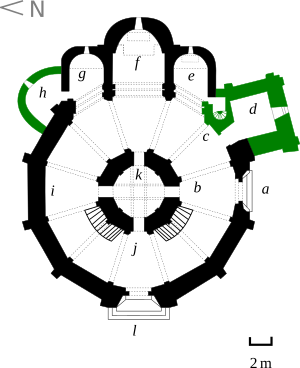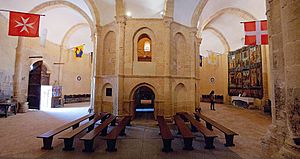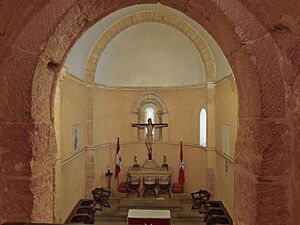Iglesia de la Vera Cruz, Segovia facts for kids
Quick facts for kids Church of the True Cross |
|
|---|---|
|
Iglesia de la Vera Cruz
|
|
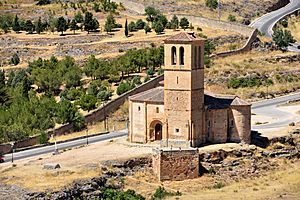
General view from the Alcázar de Segovia
|
|
| 40°57′20.56″N 4°7′56.17″W / 40.9557111°N 4.1322694°W | |
| Location | Segovia |
| Country | Spain |
| Denomination | Roman Catholic |
| History | |
| Relics held | True Cross |
| Architecture | |
| Functional status | Active |
| Heritage designation | Bien de Interés Cultural |
| Official name | Iglesia de la Vera Cruz Carretera de Zamarramala, 4 |
| Type | Monument |
| Designated | 4 July 1919 |
| Reference no. | RI-51-0000164 |
| Style | Romanesque, Romano-Gothic |
The Church of the True Cross (which in Spanish is Iglesia de la Vera Cruz) is a Roman Catholic church. It is found in the city of Segovia, in Spain. This church is very old and has a special shape.
It used to be called the Church of the Holy Sepulchre. It sits on a hill close to a town called Zamarramala. For many years, it was the main church for that town.
The church has a unique design. Its main part is shaped like a 12-sided polygon. Inside, there's a smaller, two-story building called an edicule. Other parts like towers and chapels were added later. It is one of the best-preserved churches of its kind in Europe. Because it's so important, it was named a Spanish Property of Cultural Interest in 1919.
Contents
A Look at the Church's History
People once thought the Knights Templar built this church. But now, experts believe it was built by the Order of the Holy Sepulchre of Jerusalem. This group was like a branch of a larger church in Zamora.
The church was officially opened on September 13, 1208. A special stone near a side door tells this story. It says, "Let the founders of this temple be placed in the heavenly seat."
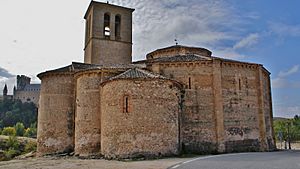
In 1531, the Order of the Holy Sepulchre joined with the Order of St. John of Jerusalem. Because of this, the church then belonged to the Sovereign Military and Hospitaller Order of St. John of Jerusalem, Rhodes and Malta.
Over time, new parts were added to the original building. First, a chapel (called an apse) was built, which is now used as a sacristy. Then, a tower was added. Later, three more apses were built, giving the church its current look.
In 1692, the church stopped being the main church for Zamarramala. A stone statue of the Virgin of Peace became the church's special protector. This statue is in one of the chapels.
The church was officially recognized as a Spanish Property of Cultural Interest in 1919. On May 31, 1951, the Sovereign Military Order of Malta took charge of the church again. They are still responsible for keeping it safe and well-preserved today.
How the Church Was Built
The church was built in the Romanesque style. This style was popular a long time ago. It was also starting to show signs of the later Gothic style.
The main part of the church has 12 sides. Inside this main area is a two-story building called an edicule. Three chapels (apses), a round sacristy, and a square tower were added to the church. A small lantern-like structure rises from the roof.
This type of church design was common for groups like the Crusaders. They often copied famous buildings in Jerusalem, like the Dome of the Rock and the Basilica of the Holy Sepulchre. Other churches built in this style include those in London and Tomar.
The outside walls are made of large, cut stones. Small, rounded windows let light into the church. Strong supports called buttresses help hold up the building's edges.
The tower is square with a pointed roof. It has four levels. The top level holds the bells and has two arched windows on each side. The bottom of the tower also has strong buttresses.
The church has two doors. The main door is on the west side. It has a flat space above it and four decorated arches. On each side of the door, three columns have carvings of birds, warriors, people, and mythical creatures. Above this door is a window.
The side door is on the south side. It has a simple rounded arch. Above this door, there is a carving that shows the Holy Women and an angel at Jesus's empty tomb. The arches around this door are plain. The columns have carvings of plants, people, and bird-like creatures.
Inside the Church
Inside the main part of the church, you can still see traces of old wall paintings. There are also two special spots called niches. One holds a picture of Our Lady of Philermos, who is important to the Order of Malta. The other has a picture of St. John the Baptist, another patron saint. Flags of the Order of Malta hang throughout the church. These flags represent the different parts of the Order.
In the main chapel, there is a wooden statue of Jesus on the cross from the 1200s. In the left chapel, there is a copy of the statue of St. John the Baptist. The original is in Madrid. In the right chapel, you can find the old Romanesque statue of the Virgin of Peace.
The aedicula is a small, two-story building in the center of the church. You can reach its upper floor by a double staircase. The lower floor is under this staircase. The top floor has a special dome. In the middle of this floor is an altar with beautiful decorations. The lower floor has four pointed arches and a special ceiling.
No one is completely sure what these rooms were used for long ago. Some think the upper room was where knights prepared for their journeys. The lower room might have been used for special prayers. Today, the Knights of the Order of Malta hold their religious services on the upper floor.
On the ground floor of the tower, there is a stone carving from the 1500s. It shows the symbols of a leader from the Order of the Holy Sepulchre. This spot was made to keep a piece of the True Cross. This important relic is now kept in the parish church of Zamarramala. It was moved there after some attempts to steal it.
On one of the walls of the main circular part of the church, there is an old Gothic altarpiece. This is a decorated screen that used to be in the main chapel. It dates back to 1516 and shows scenes from the life of Jesus.
Special Events
The Knights of the Order of Malta hold their religious events in this church. A very important event is the Good Friday procession. During this procession, the Knights of the Order of Malta walk in special black robes. They carry a statue of the Lying Christ and a piece of the Lignum Crucis.
See also
 In Spanish: Iglesia de la Vera Cruz (Segovia) para niños
In Spanish: Iglesia de la Vera Cruz (Segovia) para niños
- Monastery of Santa María del Parral


